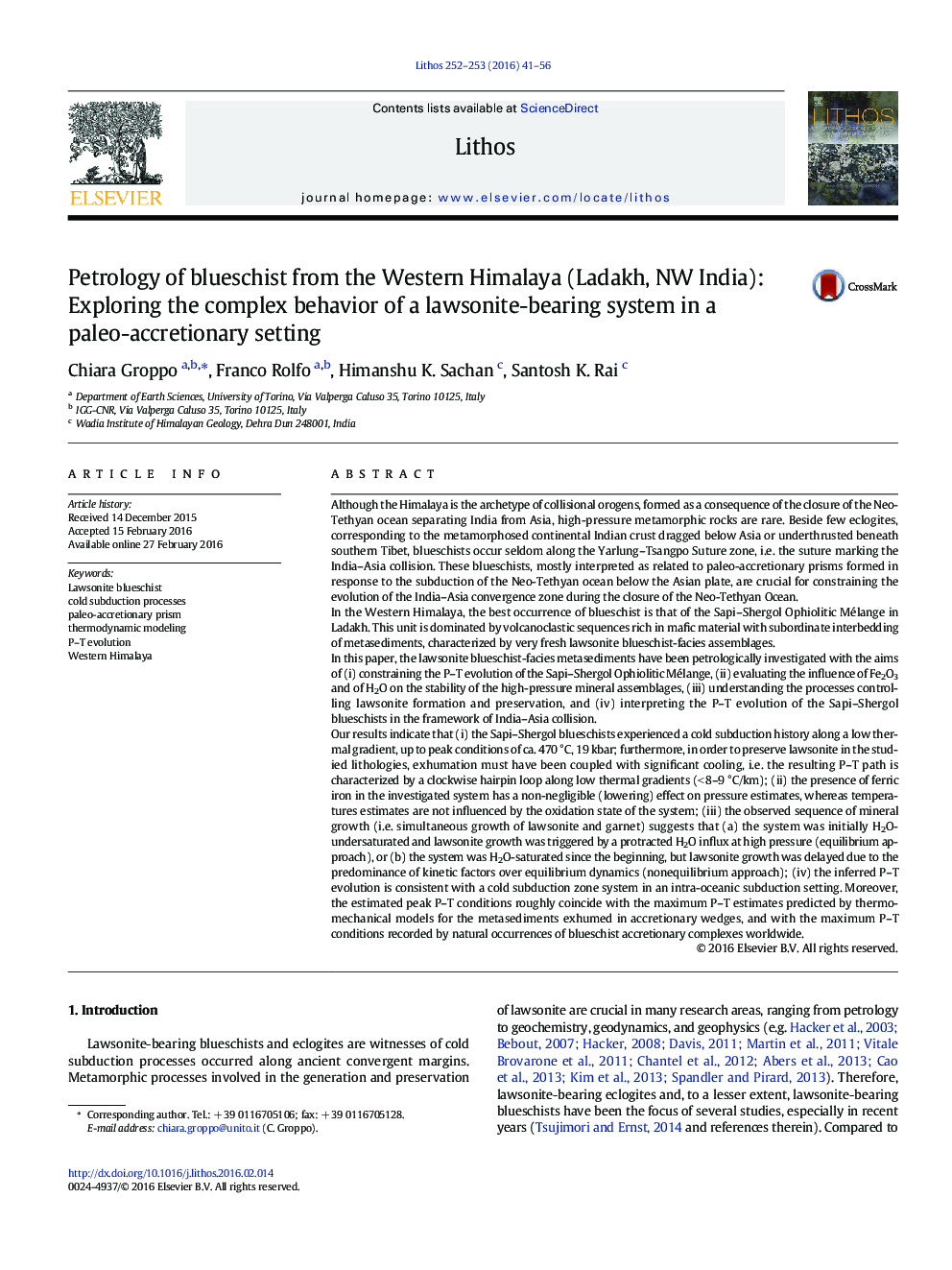| کد مقاله | کد نشریه | سال انتشار | مقاله انگلیسی | نسخه تمام متن |
|---|---|---|---|---|
| 4715574 | 1638648 | 2016 | 16 صفحه PDF | دانلود رایگان |

• The Sapi–Shergol lawsonite-blueschist metasediments are petrologically investigated.
• They experienced cold subduction history (7–8 °C/km gradient) up to 470 °C, 19 kbar.
• The presence of Fe+ 3 has a non-negligible effect on P estimates.
• Simultaneous growth of Grt and Lws implies discussion on equilibrium/nonequilibrium.
• Peak PT estimates are close to those of blueschist accretionary complexes worldwide.
Although the Himalaya is the archetype of collisional orogens, formed as a consequence of the closure of the Neo-Tethyan ocean separating India from Asia, high-pressure metamorphic rocks are rare. Beside few eclogites, corresponding to the metamorphosed continental Indian crust dragged below Asia or underthrusted beneath southern Tibet, blueschists occur seldom along the Yarlung–Tsangpo Suture zone, i.e. the suture marking the India–Asia collision. These blueschists, mostly interpreted as related to paleo-accretionary prisms formed in response to the subduction of the Neo-Tethyan ocean below the Asian plate, are crucial for constraining the evolution of the India–Asia convergence zone during the closure of the Neo-Tethyan Ocean.In the Western Himalaya, the best occurrence of blueschist is that of the Sapi–Shergol Ophiolitic Mélange in Ladakh. This unit is dominated by volcanoclastic sequences rich in mafic material with subordinate interbedding of metasediments, characterized by very fresh lawsonite blueschist-facies assemblages.In this paper, the lawsonite blueschist-facies metasediments have been petrologically investigated with the aims of (i) constraining the P–T evolution of the Sapi–Shergol Ophiolitic Mélange, (ii) evaluating the influence of Fe2O3 and of H2O on the stability of the high-pressure mineral assemblages, (iii) understanding the processes controlling lawsonite formation and preservation, and (iv) interpreting the P–T evolution of the Sapi–Shergol blueschists in the framework of India–Asia collision.Our results indicate that (i) the Sapi–Shergol blueschists experienced a cold subduction history along a low thermal gradient, up to peak conditions of ca. 470 °C, 19 kbar; furthermore, in order to preserve lawsonite in the studied lithologies, exhumation must have been coupled with significant cooling, i.e. the resulting P–T path is characterized by a clockwise hairpin loop along low thermal gradients (< 8–9 °C/km); (ii) the presence of ferric iron in the investigated system has a non-negligible (lowering) effect on pressure estimates, whereas temperatures estimates are not influenced by the oxidation state of the system; (iii) the observed sequence of mineral growth (i.e. simultaneous growth of lawsonite and garnet) suggests that (a) the system was initially H2O-undersaturated and lawsonite growth was triggered by a protracted H2O influx at high pressure (equilibrium approach), or (b) the system was H2O-saturated since the beginning, but lawsonite growth was delayed due to the predominance of kinetic factors over equilibrium dynamics (nonequilibrium approach); (iv) the inferred P–T evolution is consistent with a cold subduction zone system in an intra-oceanic subduction setting. Moreover, the estimated peak P–T conditions roughly coincide with the maximum P–T estimates predicted by thermo-mechanical models for the metasediments exhumed in accretionary wedges, and with the maximum P–T conditions recorded by natural occurrences of blueschist accretionary complexes worldwide.
Journal: Lithos - Volumes 252–253, May 2016, Pages 41–56